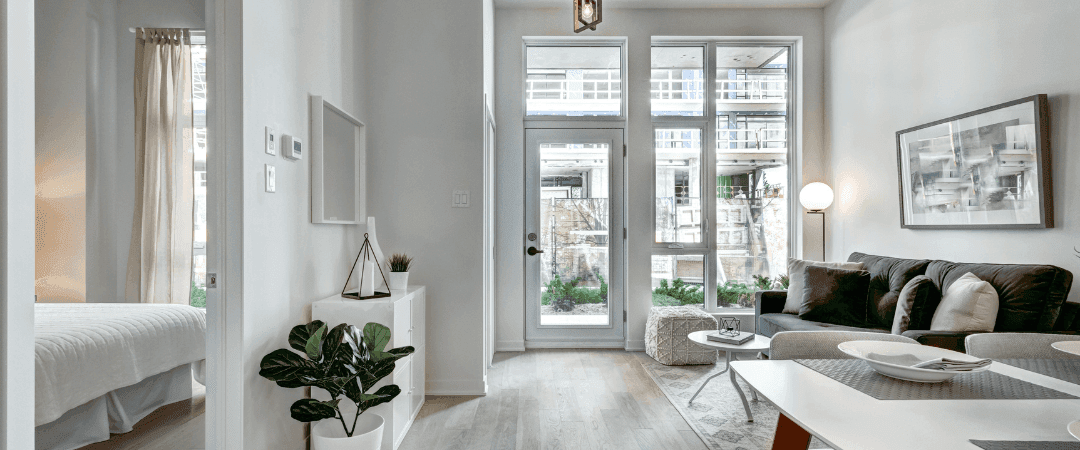
10 Ways to Prepare For Your Move: Renter's Checklist
If you’re searching for an apartment, or a room for rent make sure it stands up to your individual needs. A renter’s checklist helps to simplify the process. While it’s easy to get lost in the excitement of a new home, a checklist helps to ground you with the move. We have some recommendations on what you should plan as part of the list before, during, and after your move-in date!
1. Your Budget
It’s easy to get caught up in the multitude of options available with different buildings. But, you don’t want to get out of hand. You should budget to spend no more than 30% of your gross income on rent. This isn’t always possible in expensive cities, like Toronto or Vancouver, but you should do your best to keep your housing expenses to 30% or under. Teaming up with a roommate or creating an income-generating side hustle can help offset your living expenses.
2. The Best Time to Look For a Place
If you have some flexibility on when you can move, there are times of year when apartments are less competitive and less expensive. Rent prices are subject to change based on seasonality, and you can save on rent by being strategic about your search. As a general rule, winter is the least competitive time to look for an apartment and when you can score the best deals. This rule can even apply in warm-weather cities. Most times, it’s when families are reluctant to move their kids during the school year, college students are busy with exams or people are busy with the holidays.
3. Expenses
Upfront expenses are only a portion of the total costs associated with renting an apartment. Other costs may include utilities, parking, repairs, and new furniture. Utility costs can vary depending on your location and the season. It’s common for renters to pay for gas and electricity, as well as internet and cable. You should also factor in any subscriptions, the cost of transportation or gas, food, gym memberships, and any other ongoing expenses.

4. Neighbourhood
Narrowing down your dream neighbourhood can feel daunting. To narrow down your choices, consider the following:
- How close am I to work?
- Do I prefer driving, public transportation, or walking?
- Do I need quiet or want to live in the middle of it all?
- Is my dream location more expensive than surrounding neighborhoods?
- How far do I want to be from museums, restaurants, and attractions?
The more you can narrow down your preferences, the easier it is to settle on the perfect location for you.
5. All Upfront Costs
Remember to account for any upfront costs involved. You’ll need to budget for a security deposit, first and last months’ rent, and in some cases, an apartment application fee. If you’re moving in with a pet, this could also include a pet deposit or fee. Make sure to study your lease regarding the terms of getting your security deposit back, as well as any conditions for reimbursement.
6. Amenities
You should always prioritize amenities, as well as location. In some areas, apartment complexes come loaded with options like swimming pools, on-site fitness centers, rooftop terraces, and more. In addition to shared amenities, think about what you want inside of your apartment. An updated kitchen, outdoor space, oversized bathroom off the master bedroom, and closet space, are all worthwhile amenities to consider.
7. Organize Your Move
When signing the lease, plan out exactly when you can and intend to move in. Supposing you have an existing place that you are moving from, you want to try to have a little overlap, if possible. In a perfect world, getting the keys to the rental unit a week in advance would be ideal. If it’s not possible, it’s not the end of the world – but it does add some stress.
- Discuss the earliest move-in date possible with your landlord. Although the lease may start on a specific date, your landlord might allow some flexibility if the former tenant is moving out early.
- Enlist the help of your family and friends to start packing, or hire professional movers. Asking friends is cheaper and can be a great excuse to throw a party. However, it also requires a lot of coordination. It’s often less stressful if you hire a reputable, bonded moving company to do the planning for you. Local moving companies usually charge by the hour.
- Get moving supplies by purchasing moving boxes at your local hardware or grocery store. You can also save money with these places to get moving boxes, as well. Check out social media sites, like Craigslist and Facebook Marketplace. Finally, don’t forget to ask your neighbours, friends or family.
- Set up utilities. Most utilities can be easily set up online, although some areas may require an in-person visit. Make sure to schedule everything ahead of time to avoid a lack of internet or cable.
- Change your mailing address and set up mail forwarding. It’s best practice to schedule mail forwarding as soon as possible, such as a month before your move. Otherwise, you could end up without your mail for several weeks.
- Pack your belongings. Use smaller boxes for heavier items and bigger boxes for lighter items.
Compiling a home inventory list can make moving day easier, and can help you to determine how much insurance you should have for your belongings.

8. Inspection and Take Photos/Videos
When you do have the keys to the place, the first thing you should do is to go through it and complete a serious inspection. Create a list of every room, and every feature of the room as part of your renter’s checklist. Then take that list and document any damage, any repairs necessary, and anything else worth noting. In addition to completing your renter’s checklist, take pictures or create a video of each item to accompany the inspection. That way, if you ever have any problems with the unit or things to address when you move out, you can refer to the notes, pictures, and video. Here is a direct link to a great resource you can use.
9. Prepare the Apartment or Home
Once your renter’s checklist has been completed, you should prepare the new home for your move-in. These tasks include making minor repairs, measuring the spaces for your stuff, and painting. You should also make a list of items that you need to purchase or note which of your belongings will go into what room. This preparation phase will allow your move-in to run more smoothly and complete all the major repairs/cleaning before your stuff is in the way.
Important: Deep clean your space before you move in! A cleaning company can take care of everything for you, although they will charge a premium for the service.
10. Rent Calculator
A rent calculator can help give you a better idea of what you can and can’t afford. Plug in your location, the desired number of bedrooms, and your monthly gross income, and the rent calculator will do the rest. It provides you with a recommended rent figure, and in some cases, apartment options, in your area that fit your budget.
11. Tenant Insurance
Finally, and perhaps most importantly, get yourself renters insurance. Renters insurance is an inexpensive policy that covers you (and your stuff) in the event of a fire, flood, or other life-altering emergencies. Most landlord’s policies do not cover the items within the individual units, and while the number of events involving renters may be low, it is far better to have it than to be sorry without it. Renters insurance may be one of the best investments you make in yourself should something bad happen.

So, whether you’re planning a move or may consider it in the future, be sure to keep our renter’s checklist handy. As always, if you require Tenant Insurance, you can find a policy at iROOMit today!
